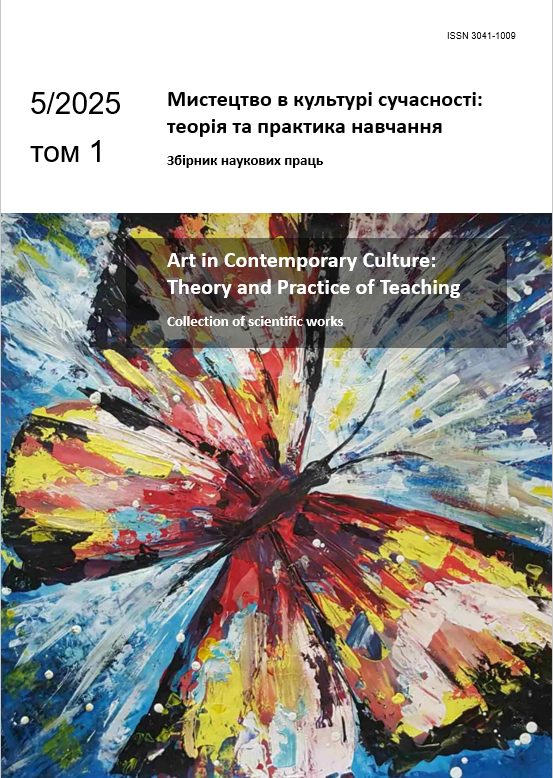Published 2025-05-15
Keywords
- color, emotional perception, method, painting

This work is licensed under a Creative Commons Attribution 4.0 International License.
How to Cite
Abstract
The article examines the role of color in a person’s everyday life, determines the influence of color on his psychophysiological state. Color and its physical and psychological nature are described. Attention is paid to the meaning of color in the culture and symbolism of different peoples of the world. Color, as a composition of color, is one of the components that directly appeals to the eye and sets the viewer up for an emotional response - this is especially connected with the human perception of various types of art (painting, architecture, sculpture, photography, cinema, decorative and applied arts, design, and others). The author focuses on the role of color in the formation of emotional perception in painting, emphasizes important elements of composition, thanks to which it is possible to use contrasting colors and highlight details or certain objects in the picture in order to interest the viewer. Attention is paid to the psychology of color. An algorithm for the formation of emotional perception in painting using color is presented. It is concluded that color harmony in painting is an aesthetically pleasing combination of colors that creates a sense of unity and balance in a work of art and is achieved using basic methods, such as monochrome harmony, which creates a sense of calm, depth and integrity of the image; analog harmony, which creates a sense of softness, harmony and smoothness; complementary harmony, which creates a sense of contrast, energy and dynamics; triad harmony, which creates a sense of balance, harmony and completeness; tetrode harmony, which creates a sense of complexity, richness and diversity. It is emphasized that each method has its own characteristics and influence on the viewer’s perception of paintings. The interpretation of different colors is presented. Color is one of the most important means of artistic expression. It is proven that color has enormous emotional potential and can affect the viewer at different levels and stages of perception. It is noted that understanding the psychology of color and skillful use of it in painting allows artists to create deep, emotionally rich works that are able to evoke a wide range of feelings and experiences in viewers. Attention is paid to computer technologies, in particular, computer graphics and color image processing. Practical advice on the use of color in painting is provided.
Downloads
References
- Іттен Й. Мистецтво кольору. Суб’єктивний досвід і об’єктивне пізнання як шлях до мистецтва. Київ: Art Haas, 2022, 96 с.
- Капран О. В. Аспекти впливу колірного рішення на сприйняття живописного твору. Науковий журнал. Слобожанські мистецькі студії. Видавничий дім «Гельветика». Суми : 2023. випуск 1. С. 14-17. DOI https://doi.org/10.32782/art/2023.1.3
- Лисиця В. Т. Колірні моделі та закони поширення світла: навчальний посібник. Харків: ХНУ імені Н. В. Каразіна, 2012. 82 с.
- Прищенко С. В. Кольорознавство: навчальний посібник / за ред. Проф. Є. А. Антоновича. К.: Д АКККіМ. 2009. 358 с.
- Прищенко С. В. Кольорознавство: навчальний посібник. Київ: Кондор, 2018, 436 с.
- Тканко З. Колір як засіб вираження в мистецтві та моді. Вісник Львівської національної академії мистецтв. 2010. Вип. 21. С. 128-138. https://lnam.edu.ua/files/Academy/nauka/visnyk/pdf_visnyk/21/15.pdf
- Komarovska Oksana, Vlasova Valeria, Pet’ko Lyudmila, Voloshenko Anna, Holinska Tetiana and Prodius Oksana (2024). The influence of arts education on love of the natural environment. E3S Web of Conferences. 538, 05004 (2024). DOI: https://doi.org/10.1051/e3sconf/202453805004;





